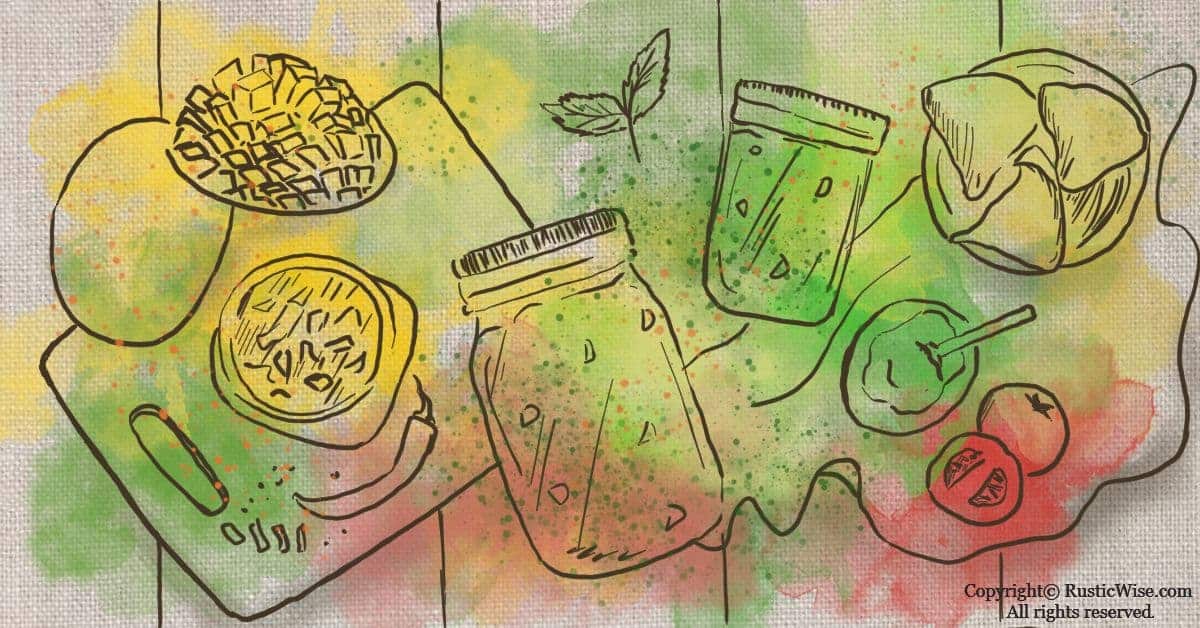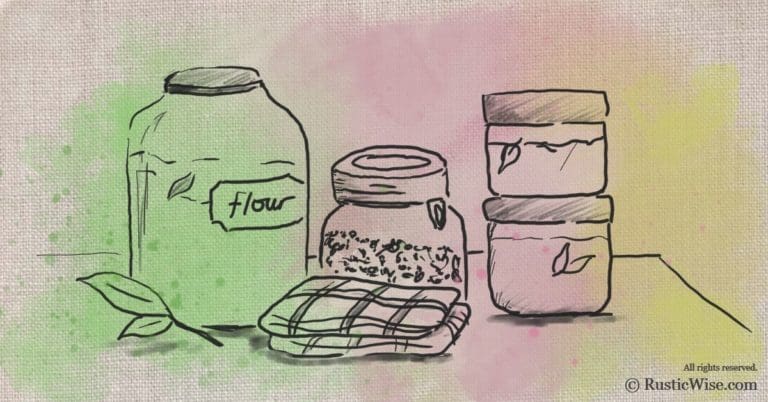Canned Chutney Recipes: 10 Bold and Flavorful Chutneys You’ll Love
Canning chutney is a surprisingly simple process that can be done at home. The canned chutney recipes in this article are perfect for your canning adventures. They’re bold and flavorful, with a variety of ingredients that will satiate a range of tastes. We’ll talk about the importance of vinegar and pickling salt, as well as acidity in canning. Plus, we’ve rounded up 10 bold canned chutney recipes that should satisfy your cravings!
If you want to learn more about canned chutney recipes or canned food preservation methods, keep reading!
What exactly is chutney?
Not quite a relish, not exactly a jam, chutney straddles the divide between sweet and savory, and often brings a dash of spice! Popular in Indian cuisine, you may have encountered a chutney or two as an accompaniment for samosas.
Chutneys are traditionally made with fruits, vegetables, sugar and vinegar. They usually have a tangy flavor, and may range from mildly spicy to mouth-on-fire hot! Use chutney to add some zest to any dish.
Because of the wide range of interesting flavor profiles and ingredients used, chutney is gaining popularity in the western world as a flavorful condiment that complements both sweet and savory dishes.
So add a generous spoonful of tomato chutney to your scrambled eggs. Amplify the flavors of pork chops with a side of peach chutney. Take that plain grilled cheese sandwich to the next level with a spread of apple chutney.
The sky’s the limit when it comes to ways to incorporate chutney into everyday dishes.
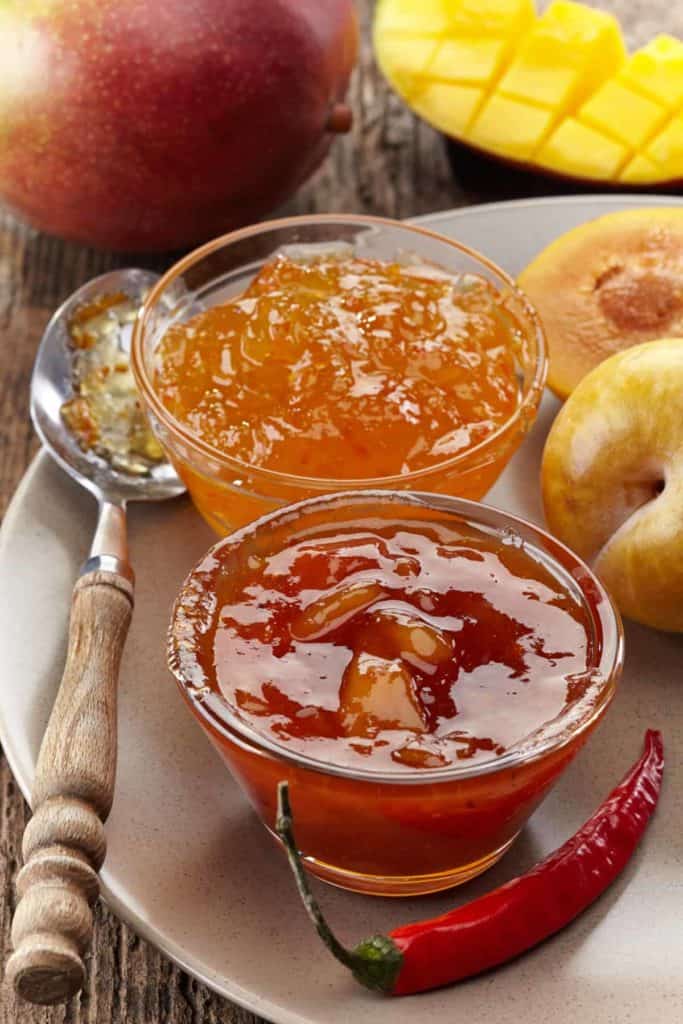
The importance of vinegar and pickling salt in chutneys
When it comes to canning chutney, it’s important to use the right kinds of vinegar and salt.
Vinegar and salt are preserving agents that ensure your food stays shelf-stable for a long time.
So what kind of vinegar and salt should you use? Let’s take a closer look.
Tip: Whatever vinegar you decide to use, just ensure it contains a minimum of 5 percent acidity. This is essential to safe canning. Any vinegars, such as some wine or homemade vinegars with less than 5 percent acetic acid are not suitable for canning.
The role of acidity in safe canning
The acidity level in foods plays a huge role in canning safety and the method of canning used.
For example, high acid fruits used to make jams and jellies contain naturally high levels of acid which makes them safe to can using a water bath canner (boiling water method).
Other foods such as tomatoes, or pickles, require the use of vinegar to increase acidity levels to a safe zone. This is the case with most chutneys.
Other low acid foods such as most vegetables, meat, fish, and poultry must always be preserved using a pressure canner.
As a refresher, the pH scale ranges from 0 to 14 with pH 7 considered neutral. Anything below pH 7 is acidic; anything above is alkaline or basic.
When it comes to acidity in home canning, the cutoff is a pH level of 4.6. Anything higher than pH 4.6 is considered “low acid” and must be canned using a pressure canner. Anything lower than pH 4.6 is a “high acid” food which can safely be processed using a water bath canner and two piece lids.
Tip: Never alter the amount of salt or vinegar in canning recipes as it may result in improperly processed foods which can lead to botulism poisoning. It’s important to follow a reliable recipe carefully.
Canning supplies
If you’re new to canning, we highly recommend you read up on canning basics first. Check out, How To Can Food: The Definitive Guide.
Let’s gather together a few supplies:
- Water bath canner, or large stockpot
- Canning rack
- Clean canning jars, lids, and screw bands
- Jar lifter
- Headspace measurer
- Canning funnel
Other kitchen supplies you may already have:
- Colander
- Stainless steel or nonreactive saucepan
- Ladle
- Wooden spoons
- Cutting board
- Knife
- Vegetable peeler
- Various sized bowls
- Measuring cups and spoons
- Oven mitt
- Clean dish rags (for wiping spills)
For a more in-depth look at canning equipment and supplies, read Essential Home Canning Equipment List: What You Need To Get Started
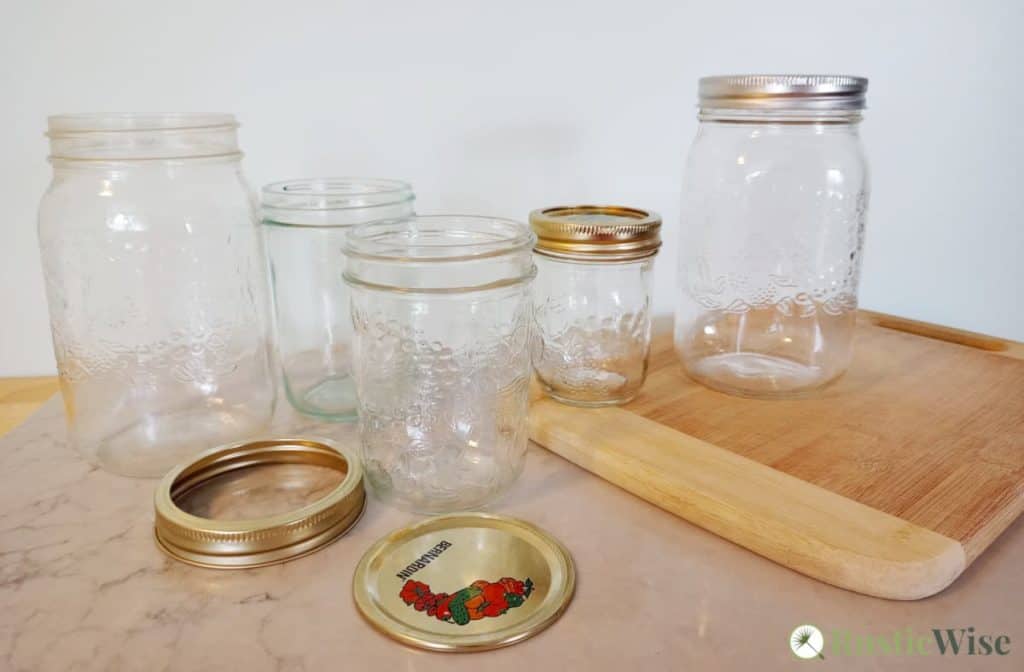
Canned chutney recipes
The first two recipes (green mango and tomato/cashew) are adapted from the wonderful book, Canning for a New Generation: Bold, Fresh Flavors for the Modern Pantry by Liana Krissoff.
If you’re looking for a modern twist on canning recipes, this book provides many fresh recipes I’m sure you’ll love.
1) Green Mango Chutney with Whole Spices
As the name says, you’ll need green, unripe mangoes for this chutney. You might find these at specialty food stores, or Asian grocery stores labeled specifically as “green mangoes” which will retain their green color even once ripened.
Rather than the sweetness you’re probably used to from ripe mangoes, green mangoes “up” the tartness factor.
The original recipe calls for kalonji seeds also known as black caraway seed, or black cumin. Kalonji seeds provide a robust flavor: slightly nutty, with a dash of smokiness and herbs, plus a hint of licorice. These seeds aren’t always easy to find, so I’ve substituted cumin seeds in its place.
Tip: Here’s a handy tip from the National Center for Home Food Preservation about handling green mangoes. Did you know that green mangoes belong to the same plant family as poison ivy? As such, some people experience skin irritation when preparing green mangoes. Wear gloves while cutting mangoes and avoid touching your face, eyes, or mouth until you’re done prepping the mangoes.
Yield: 11 half-pint jars, or 4 pint jars
Ingredients:
- 6 pounds (roughly 6 medium mangoes) of green mangoes
- 2 tablespoons fennel seeds
- 1 tablespoon green cardamom pods, slightly crushed
- 1 tablespoon whole black peppercorns
- 4 teaspoons fenugreek seeds, crushed
- 2 teaspoons cumin seeds
- 2 teaspoons whole cloves
- 1 teaspoon ground cinnamon
- 4-1/2 cups sugar
- 4 teaspoons kosher salt
- 2 small hot green chilis minced (you can use serrano, or habaneros, or jalapenos)
- 1 cup distilled white vinegar (5 percent acidity)
2) Tomato and Cashew Chutney
There are so many varieties of tomato chutneys you can make, but this recipe’s delectable ingredients from Roma tomatoes to dried fruits and chili peppers combine to make an unforgettable symphony of flavors.
Yield: 7 half-pint jars
Ingredients:
- 1 tablespoon vegetable oil
- 6 ounces onion, diced (roughly 1 small onion)
- 2 tablespoons fresh ginger, minced
- 2 teaspoons brown mustard seeds
- 1 teaspoon cumin seeds
- 1 teaspoon crushed fenugreek
- 1 cup unroasted cashews, coarsely chopped
- 1/2 cup diced dried mangoes, golden raisins, or diced dried apricots
- 3 pounds tomatoes (Roma), peeled and diced
- 3 jalapenos, seeded and diced
- 1/2 teaspoon ground cayenne
- 4 teaspoons pure kosher salt
- 3/4 cup sugar
- 1/2 cup cider vinegar (5 percent acidity)
3) Peach Chutney
Sweet peaches paired with zesty ginger and spicy chilis make this peach chutney a knock-out. Pair with pork chops, or use as a spread on grilled cheese sandwiches (via Food and Wine).
4) Peach, Pear and or Apple Allspice Chutney
This versatile recipe works well with either peach, pear, or apples—so use up whatever you have the most of! Garlic, shallots, and allspice bring the flavor. Pair with soft cheese or pate (via Bernadin).
5) Cranberry Quince Chutney Recipe
If there’s a fruit that embodies fall and winter, I would have to say it’s cranberries. This warm and sweet chutney is perfect for the chilly months. It makes a nice gift, or adds a sweet touch to a cheese platter (via Serious Eats).
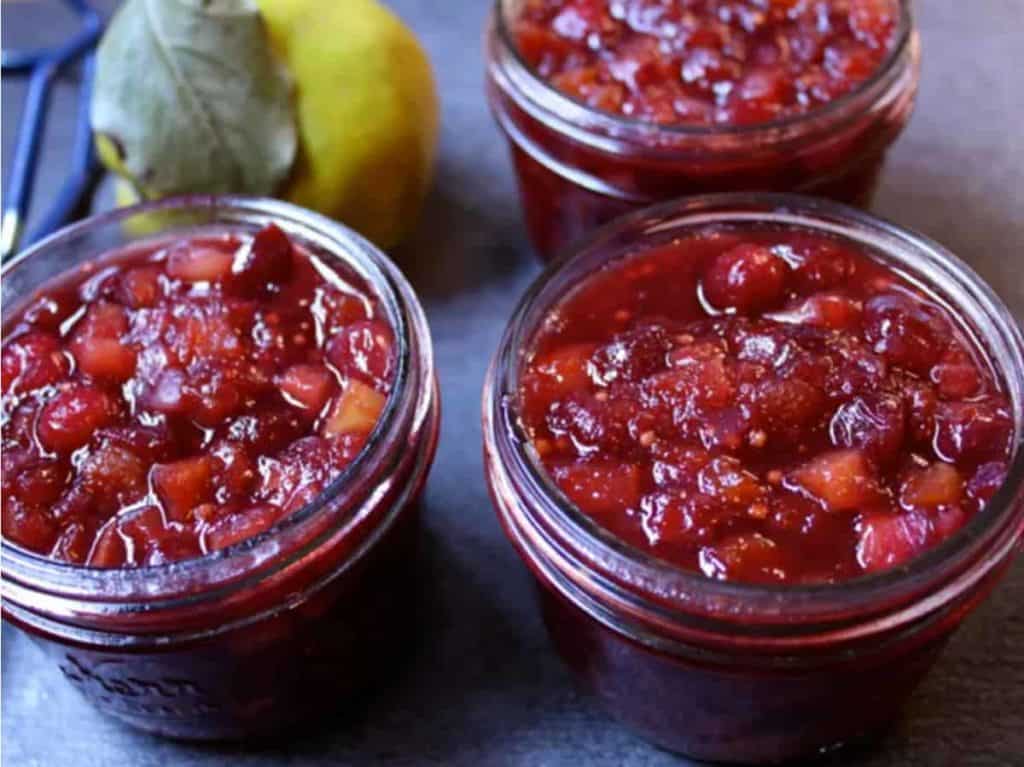
Credit: Serious Eats
6) Cinnamon-Plum Chutney
Ripe plums combine with onions and a dash of cinnamon for the perfect savory-sweet condiment (via Bon Appetit).
7) Orange Rhubarb Chutney
Slightly tangy, slightly sweet, rhubarb and orange combine seamlessly with dark brown sugar (via Boxwood Avenue).

Credit: Boxwood Avenue
8) Pineapple Mint Chutney
At first thought, pineapple and mint don’t seem like two ingredients that go well together. However, once you throw in a dash of hot pepper flakes, sweet onions and bell peppers, you have a bold, tropical chutney (via Robert Rose).
9) Adaptable Chutney Recipe with Apples, Ginger & Lemon
Apples combine with fresh ginger and red pepper flakes to create a flavorful tart chutney. Pair with a grilled cheddar cheese sandwich, or with your favorite pork dish (via Alexandra Cooks).
10) Green Tomato Chutney
If you have a bumper crop of tomatoes and don’t want to wait for them to ripen, here’s the perfect recipe for you which calls for fully green tomatoes (via SB Canning).
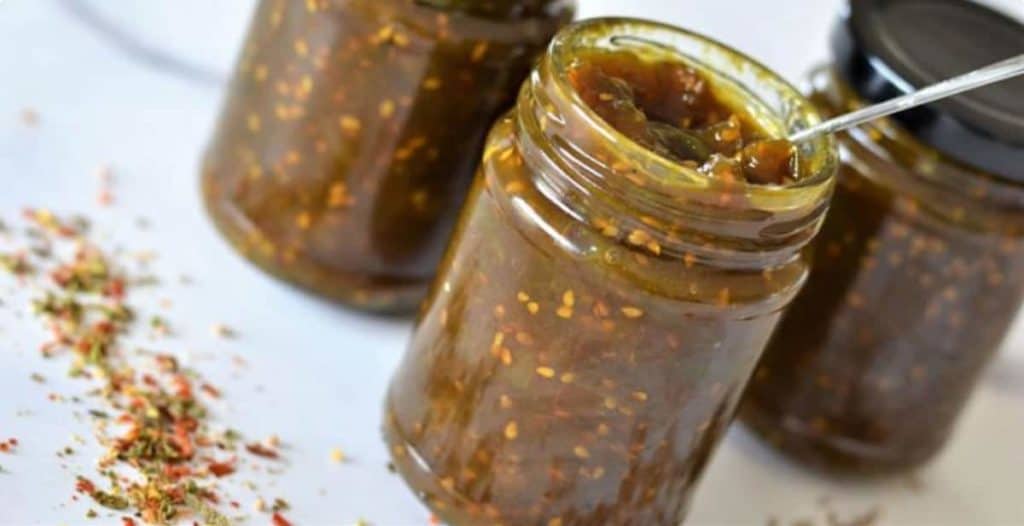
Credit: SB Canning
Related questions
Do you put chutney in jars hot or cold?
As chutneys are first cooked (and warmed), they should be packed into warm or hot jars. Placing warm food into a cold jar results in thermal shock, and the potential of glass shattering.
Also avoid putting warm, filled jars onto a cold surface such as stone countertops as this could cause breakage. Instead, place warm jars onto a layer of newspapers, a wooden cutting board, or a layer of dish towels.
Should you keep chutney in the fridge?
In the case of homemade canned chutney, they can keep safely on your pantry shelf at room temperature as long as they are properly sealed and processed.
If you have a batch of homemade chutney that hasn’t been processed, these must be kept in the fridge and used within several weeks. Same goes for any canned chutney in which the lids didn’t seal properly.
For commercial chutneys, you can store unopened jars at room temperature. Once opened, stick it in the fridge!
👉 If you like this post, see our Ultimate Guide on How To Can Food. 🍎
Would you like more timeless tips via email?
Fun tips to help you live an independent, self-sustaining lifestyle. Opt-out at any time.


References
- Krissoff, Liana (2010). Canning for a New Generation: Bold, Fresh Flavors for the Modern Pantry. Stewart, Tabori & Chang. p. 70. ISBN 978-1-58479-864-4.
- National Center for Home Food Preservation (NCHFP), Ensuring Safe Canned Foods, https://nchfp.uga.edu/how/general/ensuring_safe_canned_foods.html. Accessed June 2021.
- National Center for Home Food Preservation, Preparing and Canning Chutneys, https://nchfp.uga.edu/how/can_06/mango_chutney.html. Accessed June 2021.

Author: Theresa Tesolin
Theresa is co-founder of RusticWise. She helps people unleash their inner DIY spirit by encouraging them to get dirty and make or grow something from scratch.

